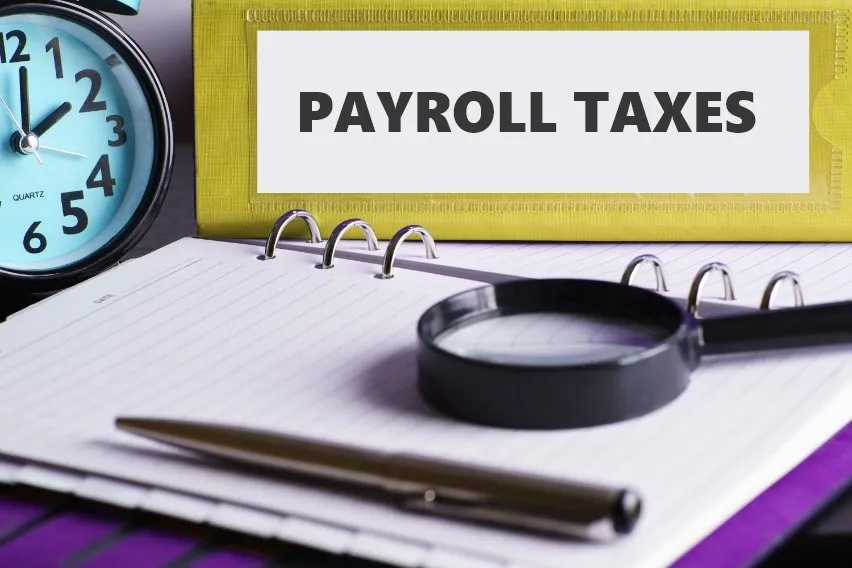Payroll Taxes: What Are They & How to Calculate Them

As an employer, have you ever wondered how payroll taxes work, how much payroll tax is, or what payroll tax is used for? Payroll taxes are calculated based on wages and salaries, paid by employers and employees. They’re critical for funding government programs like Social Security, Medicare, and unemployment benefits.
In this article, we’ll provide a detailed overview of payroll taxes. You’ll learn more about who pays them, and how they work, and we’ll give you a step-by-step guide on calculating employer payroll taxes, with examples to better illustrate the process.
Table of Contents
- What is a Payroll Tax?
- Who Pays Payroll Taxes?
- How do Payroll Taxes Work?
- Payroll Tax vs. Income Tax
- How to Calculate Employer Payroll Taxes
- Payroll Tax Withholding Example
- Simplify Payroll Tax Handling with FreshBooks Payroll
- FAQs on Payroll Taxes
Key Takeaways
- Payroll taxes are used to fund social programs including unemployment benefits, Social Security, and Medicare.
- In 2024, payroll taxes make up 49.55% of all federal tax revenue in the country.
- Payroll taxes are paid by the employer as well as the employee, under the Federal Insurance Contributions Act (FICA).
- The 2024 Social Security tax rate is 6.2%, and Medicare tax is 1.45%.
- Federal income tax rates are different from FICA, as they’re paid by the employee alone, with a marginal tax rate that changes depending on how much an employee has earned in a year.
- Cities and states sometimes differ on the amount of income taxes they levy.
- Using payroll software can reduce errors and ensure you’re up to date on all IRS changes and updates.
What is a Payroll Tax?
Payroll tax is a percentage of an employee’s paycheck that is withheld and paid to the government to fund public programs or pay for essential services. This includes programs like Social Security, Medicare, and unemployment funding. It is a mandatory deduction for both employers and employees.
Other payroll taxes include federal income tax. The money raised from this goes into the government’s general fund, which the U.S. Treasury controls.
Finally, many states, cities, and counties apply income taxes separately. Employers must also deduct these taxes from employees’ paychecks.
Payroll taxes made up 49.55% of all federal tax revenue in 2024. As such, they’re vital for keeping the country running efficiently.

Who Pays Payroll Taxes?
On the surface, it may seem like employees alone pay these types of taxes. After all, the money comes out of each employee’s pay. The taxes are also reflected on the employee’s pay stubs.
But it’s not quite that simple.
Even though payroll taxes come from the employee’s salary, they’re not responsible for actually paying the taxes. Instead, an employer withholds the money and pays it to the relevant government authority on behalf of the employee.
In this sense, the employer acts as an agent on behalf of the government. The employer collects taxes from employees’ wages and ensures those taxes go to the right place.
However, you also have to account for an employer’s share of some of these taxes. Under the Federal Insurance Contributions Act (FICA), employers must match their employees’ contributions to FICA taxes. Social Security and Medicare taxes fall into this category. In this case, the money employers pay counts as a business expense. That means they can write their contributions off when filing business taxes.
How Do Payroll Taxes Work
We can break payroll taxes down into several categories. Your company has to understand each category to meet its payroll tax responsibilities.
Social Security Tax
Social Security tax applies to any money paid to the general government that it uses to provide a future benefit. Such benefits include:
- Benefits related to accidents, injury, or sickness
- Pensions
- Reimbursement for hospital expenses
Employers must withhold a set percentage from their employees’ salaries to pay this tax. Furthermore, the employer pays an equal percentage under FICA guidelines.
The current Social Security tax rate is 6.2%, which applies to both the employer and the employee. This creates a challenge for self-employed people, as they must pay 12.4% in taxes because they’re both a business and an employee.
A maximum salary cap of $168,600 applies to the Social Security tax. Both employee and employer contributions stop upon reaching this cap.
Medicare Tax
Like Social Security tax, both the employer and the employee contribute to Medicare taxes. The current medicare tax rate is 1.45%, creating a total tax obligation of 2.9% with the employer contribution.
This money funds Medicare, which is a federal health insurance program. Medicare provides coverage to people aged 65 or over. It also covers some younger people with certain disabilities, in addition to those with end-stage renal diseases.
A wage base limit of $168,600 also applies to Medicare contributions.
Federal Income Tax
Federal income tax is a little more complicated than the FICA taxes. There are seven percentage tiers to consider. What applies to an employee depends on how much they earn per year. The brackets for single people in 2024 are as follows:
- 10%: $0 to $11,600
- 12%: $11,601 to $47,150
- 22%: $47,151 to $100,525
- 24%: $100.526 to $191,950
- 32%: $191,951 to $243,725
- 35%: $243,726 to $609,350
- 37%: $609,351 or higher
Note that this is a marginal tax rate. This means you apply the rate solely on the income that falls into that range. Also, the rates differ if your employee files their taxes jointly.
For example, let’s assume an employee earns $50,000 per year. In this case, you apply the 12% rate to all money earned up to $47,150. From there, you apply the 22% rate to the rest of the employee’s income. If their wage rises to $101,000, you will apply the 24% rate to earnings above $100,525, with the lower rates applying elsewhere.
State and Local Income Tax
The FICA and federal income taxes apply to all employers. Things get a little more complicated when you take local and state income taxes into account.
Currently, only seven states don’t apply any sort of local tax on income: Alaska, Nevada, Florida, Texas, Wyoming, Tennessee, and South Dakota.
Some states have a flat income tax rate. This means they apply the same rate to all incomes, regardless of how high or low that income is. The states with a flat rate are as follows:
- Colorado
- Indiana
- Kentucky
- Illinois
- Massachusetts
- Michigan
- Utah
- Washington
- Pennsylvania
- New Hampshire
- North Carolina
Furthermore, there are variations in how the above states apply their flat rates. New Hampshire only taxes income from dividends and interest, which means employers often don’t have to worry about this state tax. Washington only applies its state income tax to the capital gains of high earners.
The rest of the states in the union have a graduated-rate income tax. This works the same way as federal income tax does in terms of having set tax brackets.
It gets more complicated.
Some cities apply taxes beyond state taxes. For example, San Francisco levies a 0.38% income tax on top of state and federal income taxes. Similarly, Wilmington in Delaware has a 1.85% tax on income. As a consequence, you may have to apply these taxes when working on your income tax withholding calculations.
A final complication comes in the form of varying tax rates. Each state has different rules, which you need to understand before making your calculations. It may be a good idea to speak to a financial advisor to ensure you handle state employment taxes correctly.
Federal Unemployment Tax
The Federal Unemployment Tax Act (FUTA) states that employers must pay a tax that funds unemployment systems.
These systems offer support to people who lose their jobs. If an employee loses their job, they can claim unemployment benefits designed to help them until they find another job.
The majority of employers pay both federal and state unemployment taxes. But these taxes aren’t deducted from employee paychecks. Instead, employers have sole responsibility for paying this tax.
For this reason, it may appear that the FUTA tax isn’t a payroll tax. But that isn’t the case. The amount the employer pays depends on an employee’s wages, making FUTA a payroll tax. Currently, employers only pay federal unemployment taxes up to a fixed threshold of $7,000 per employee.
Some employers may also claim a credit against their FUTA tax obligations. This usually applies if the employer has to pay into a state unemployment fund. The credit varies depending on the state.
Payroll Tax vs. Income Tax
Calculating payroll tax is different from income tax. While both are employment taxes, they’re separate deductions. As a business owner, it is your responsibility to understand income and payroll tax calculations. The following chart will assist you in understanding your obligations, as well as what the taxes are put toward.
| PAYROLL TAXES | INCOME TAXES | |
| Paid by: | Both the employer and the employee | The employee |
| Rates: | Medicare, SUTA, FUTA, and Social Security rates vary. | Depends on the employee’s filing status and their annual income. Marginal tax rates range from 10% to 37%. |
| Includes: | Employee and employer federal taxes and state taxes. | Employee federal, state, and local taxes owed. |
How to Calculate Employer Payroll Taxes
Calculating payroll taxes can get complicated as you need to satisfy all of the above categories. Small business owners may find the calculations challenging when trying to account for all of their employees. The following steps help when figuring out how payroll tax is calculated, and how much an employer needs to withhold and pay in payroll taxes.
1. Calculate FICA Taxes
FICA taxes include the taxes paid for Social Security benefits and Medicare.
Start with Social Security.
Multiply the employee’s gross pay for the relevant pay period by the current Social Security tax rate of 6.2%. Withhold this amount from the employee’s pay. Furthermore, match the figure to reach the 12.4% rate.
Do the same with Medicare tax. Multiply the employee’s gross pay by the current 1.45% rate. Withhold this amount while also matching it with your contribution.
2. Calculate Federal Income Tax
Assuming the employee files their taxes using Form W-4, you can calculate how much federal income tax to withhold by doing the following:
- Locate the worksheet titled “Wage Bracket Method Tables for Manual Payroll Systems With Forms W-4 From 2020 or Later.” It’s in IRS Publication 15-T.
- Check Form W-4 to see if the employee files taxes jointly or individually.
- Enter the employee’s total taxable earnings on line 1a of your worksheet.
- Record the number of pay periods on line 1b.
- Input the amount your employee enters in Step 4a of their Form W-4 on line 1c. Then, divide this number by the number of pay periods and write that number in line 1d.
- Add the sum of lines 1a and 1d to line 1e.
- Enter any of the employee’s deductions in line 1f. You should find this figure in Step 4b of the employee’s Form W-4.
- Divide the figure in 1f by the number of pay periods and enter the result in line 1g.
- Subtract the figure in 1g from the one in 1e to get the employee’s Adjusted Wage Amount. If this is 0 or less, enter 0.
- Use the table in the worksheet that corresponds to your payroll period to find the Tentative Withholding Amount.
- Claim tax credits from Step 3 of the employee’s Form W-4 using lines 3a to 3c of your worksheet. If this doesn’t apply, use the figure from line 2a for line 3c.
- Enter any additional amount to withhold from Step 4c of the employee’s Form W-4 into line 4a.
- Add the number in line 4a to that in line 3c to get the amount of federal income tax you need to withhold from the employee’s pay.
3. Apply state and local taxes.
It’s difficult to offer a calculation for this step as state and local taxes vary. Generally speaking, you apply the percentages for your state to your employee’s gross pay. Withhold this amount, which you earmark to pay to the relevant state or local authority.
For example, California has a graduated state tax of between 1% and 13.3%, depending on the employee’s income. It also has a state sales tax rate of 7.25%. Though you may not need to account for the sales tax when calculating payroll taxes, you do need to consider the graduated state tax.
Let’s assume your employee earns $24,000. In this case, you apply the 1% state tax rate up to $10,412, creating a tax burden of $104.12. However, a graduated 2% rate applies to the earnings between $10,412 and $24,684. So, you apply a 2% rate to $13,588, creating a tax burden of $271.76. In total, the employee pays $375.88 in state taxes.
4. Calculate FUTA
Thankfully, it’s much easier to calculate the FUTA rate. Simply set aside 6% of the first $7,000 you pay to the employee. Note that the business pays this tax. It’s not withheld from the employee’s paycheck.
It’s also worth noting that some states receive FUTA credits, which may apply to your payments. These credits cover a maximum of 5.4% of the 6% you pay. But, not all states are eligible for the maximum credit.
Payroll Tax Withholding Example
The following is a quick example of how to calculate employer payroll taxes that apply to Social Security taxes.
Assume an employee earns $4,000 for the current pay period. Multiplying this figure by 6.2% tells you how much of that money to withhold:
4,000 x 0.062 = 248
As such, you withhold $248 from the employee’s pay. Furthermore, you must match this $248 with an employer contribution.

Simplify Payroll Tax Handling with FreshBooks Payroll
From FICA to Social Security calculations, payroll taxes can get extremely complicated, but it’s essential to properly manage them, with careful attention to detail. It can all seem overwhelming, but with FreshBooks Payroll software, you can easily address all your payroll needs, including staying current with IRS changes and updates to reduce manual errors and eliminate fines. FreshBooks’ simple interface and powerful business solutions will help you improve compliance with state and federal payroll tax laws while streamlining, automating, and calculating payroll tax deductions.
FreshBooks also offers easy invoicing, bookkeeping, and financial management. Whether you’re a solopreneur or the owner of a growing business, you can try FreshBooks for free today to find out what this comprehensive accounting software can do for you.
FAQs on Payroll Taxes
Looking for more information on payroll tax withholding after learning the payroll tax definition and how much employer payroll taxes are? The following are some answers to the most frequently asked questions in 2024.
What percentage of payroll should payroll taxes be?
Payroll taxes (FICA and Medicare) should be 15.3%, with 7.65% paid by the employer, and 7.65% paid by the employee. This is calculated by adding the Social Security tax rate of 6.2% (or 12.4% when you include the employer contribution) with the Medicare tax rate of 1.45% (or 2.9% with the employer contribution).
Is payroll tax deductible?
Some payroll taxes may be deductible. If you’re a business owner and you have employees, you can deduct the employer-paid portion of payroll taxes, but not the full amount that goes toward federal taxes, Social Security, and Medicare tax.
Who Is exempt from payroll taxes?
An employee may claim an exemption if they have the right to a refund on all income taxes withheld during the previous year. This usually happens if they have no tax liability for that year.
They may also claim an exemption for the current year if they expect to have no tax liability.
How can I reduce my payroll taxes?
Payroll FICA and Medicare use set percentages, meaning you can’t alter how much an employee pays. However, employers may be able to deduct some of the taxes they contribute or claim credits for some taxes.
About the author
Michelle Payne has 15 years of experience as a Certified Public Accountant with a strong background in audit, tax, and consulting services. Michelle earned a Bachelor’s of Science and Accounting from Minnesota State University and has provided accounting support across a variety of industries, including retail, manufacturing, higher education, and professional services. She has more than five years of experience working with non-profit organizations in a finance capacity. Keep up with Michelle’s CPA career — and ultramarathoning endeavors — on LinkedIn.
RELATED ARTICLES


 How Much Does Bookkeeping Cost?
How Much Does Bookkeeping Cost? Ecommerce Bookkeeping: The Small Business Guide
Ecommerce Bookkeeping: The Small Business Guide Shopify Bookkeeping: The Complete Guide for 2025
Shopify Bookkeeping: The Complete Guide for 2025 Bookkeeping for Property Management: 8 Best Practices
Bookkeeping for Property Management: 8 Best Practices 15 Bookkeeping Tips: Every Small Business Needs to Know
15 Bookkeeping Tips: Every Small Business Needs to Know How To Pay Independent Contractors In 2025
How To Pay Independent Contractors In 2025